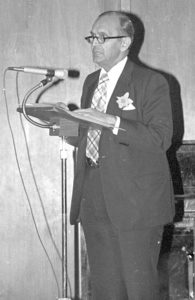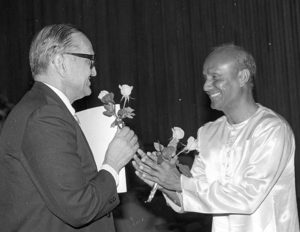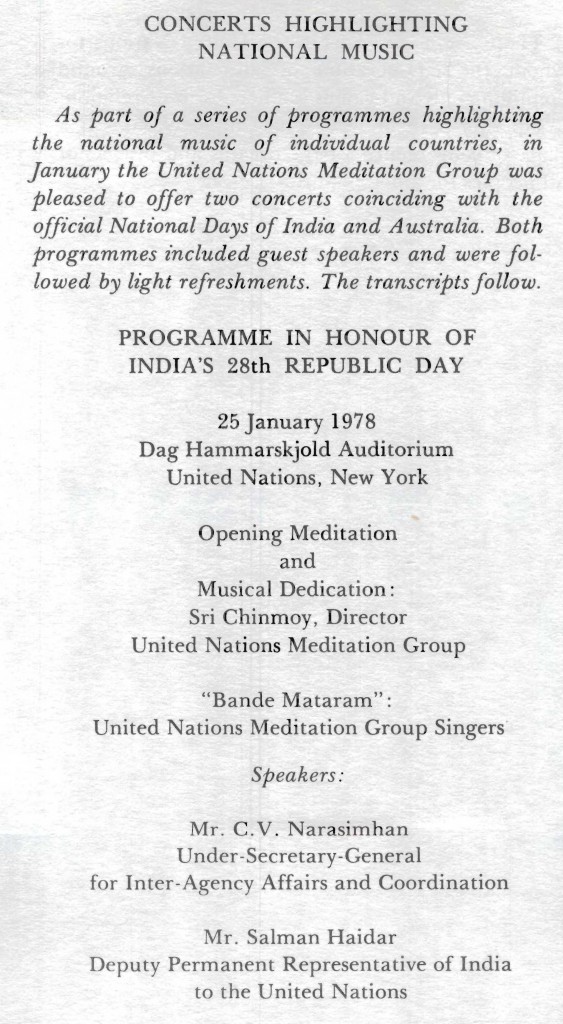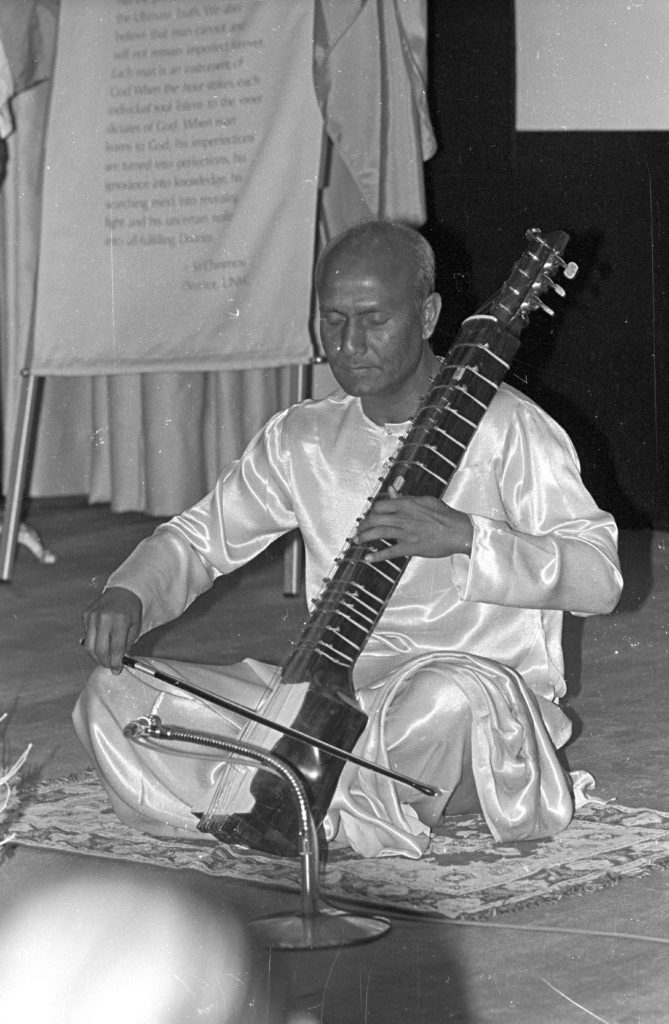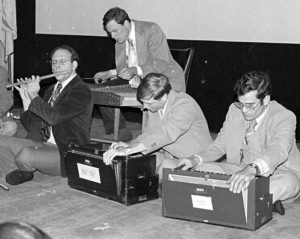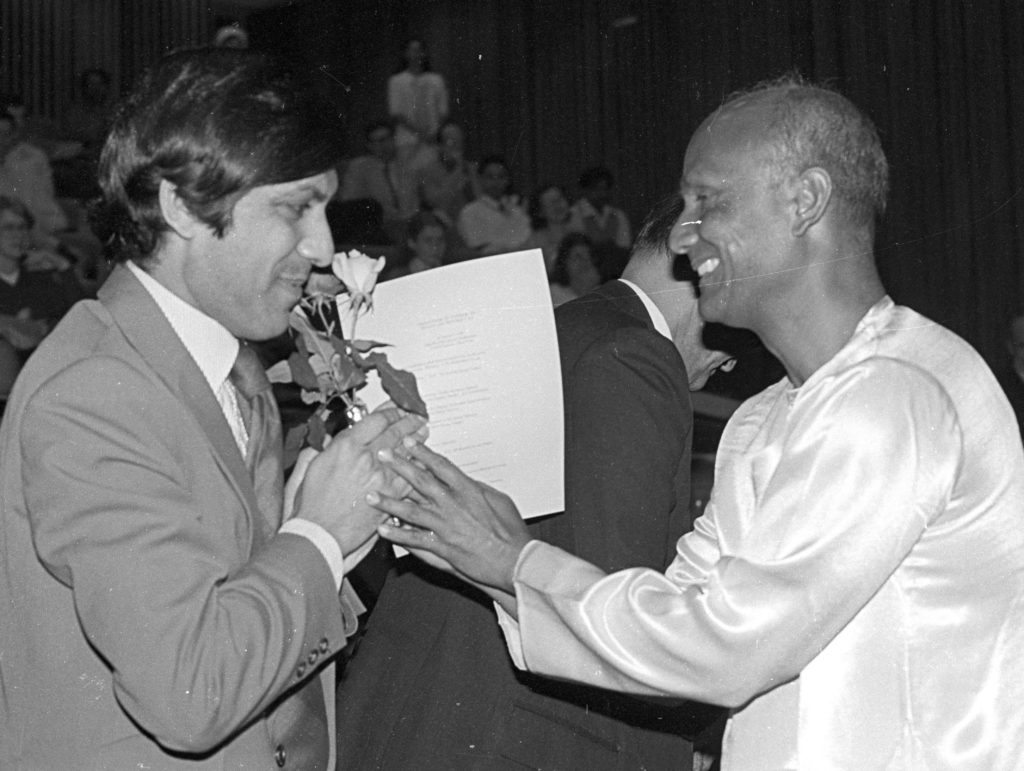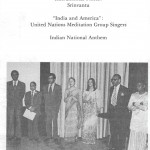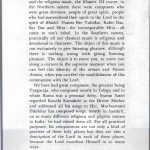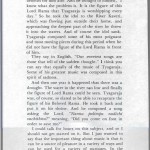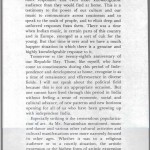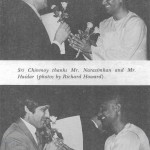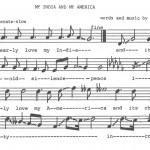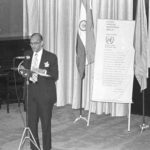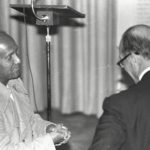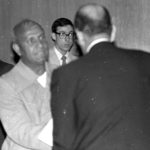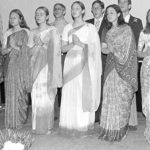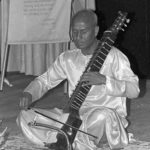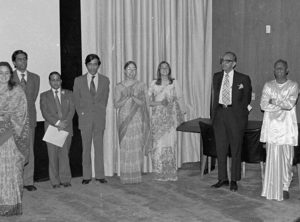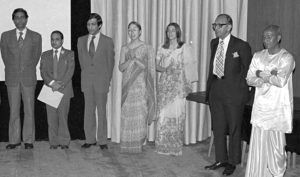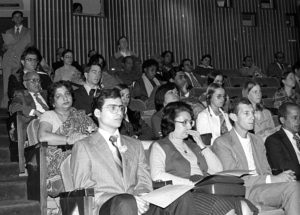Concert Highlighting India’s Music, 1978 Jan 25: DETAILS
Filed under asia-oceana | Music and Songs | Tributes and Expressions of appreciationText pdf:
bu-scpmaun-1978-01-27-vol-06-n-01-jan-pp-22-33-india
CONCERTS HIGHLIGHTING NATIONAL MUSIC
As part of a series of programmes highlighting the national music of individual countries, in January the Peace Meditation Group was pleased to offer two concerts coinciding with the official National Days of India and Australia. Both programmes included guest speakers and were followed by light refreshments. The transcripts follow.
PROGRAMME IN HONOUR OF INDIA’S 28th REPUBLIC DAY
25 January 1978, Dag Hammarskjold Auditorium, United Nations, New York,
Opening Meditation and Musical Dedication : Sri Chinmoy, Leader of the Peace Meditation Group at the UN
“Bande Mataram”: Meditation Group Singers
Speakers :
Mr. C.V . Narasimhan, Under-Secretary-General for Inter·Agency Affairs and Coordination
Mr. Salman Haidar, Deputy Permanent Representative of India
to the United Nations
Three Songs Dedicated to the United Nations: Meditation Group Singers
Slides of India
Instrumental Pieces: Srinvantu
“India and America”: Meditation Group Singers
Indian National Anthem Guests join with Meditation Group members in the singing of India’s national anthem
Mr. C. V. Narasimhan, Under-Secretary-General for Inter-Agency Affairs and Coordination:
(text to be better formatted with photos)
Sri Chinmoyji, dear friends , I am delighted to join you on this occasion when you are celebrating the 28th anniversary of the establishment of the Republic of India , which is due to take place tomorrow. I am also glad that you are dedicating your programme to the music of India. In the course of Mr. Peck’s letter to me he said that perhaps I could offer a few brief remarks regarding my perceptions of the nature and beauty of the native music of India. And so, those are my terms of reference.
I would like to begin by saying that music means different things to different people. For some, listening to music is just a source of aesthetic pleasure; nothing wrong with that. For some, music can be exciting, like the beat of the pop music or rock music. You €an use music to croon, to serenade , to conquer the heart of your beloved.
You can use music as an instrument for a variety of purposes. But today I intend to talk of the classical music of India, especially of the southern Indian system with which I am most familiar , and the way in which this music could be an instrument for
achieving communion with the Lord.
I think it was perhaps a year ago that I was invited by the Meditation Group to give a brief exposition of the Bhagavad-Gita and it gave me great pleasure to do that. At that time, I pointed out that in the Gita, the Lord says that there are several Yogas, several systems of Yoga, and all of them are, of course, a means of reaching God. Yoga itself means the uniting, the joining, of the individual atman to the supreme Para m Atman. Specifically, the Lord in the Gita has identified the way of knowledge, or Jnana Yoga, the way of devotion, or Bhakti Yoga, and the way of serving mankind, Karma Yoga.
Now, Bhakti Yoga means many things, it does not mean just devotion to the Lord. Bhakti is a very complex concept. It involves the idea of renunciation; it involves the idea of acceptance of the Will of the Lord; it involves the complete surrender of your ego to the Lord. It involves many other things and to understand Bhakti in its fullest form, I would have to talk for quite some time. I do not intend to do that today. But what I do want to say is that Bhakti Yoga is one of the best ways of reaching the Lord. And one of the easiest ways, and at the same time one of the sweetest ways of reaching the Lord through Bhakti Yoga is by music.
I
n the Western system, classical music is mainly secular. You have some great music, some of the music of Bach or Handel for example, which falls in the category of religious music, But by and large , the music is secular. And to a large extent, in the North Indian classical system you can distinguish between the secular music , the Khyal, and the religious music, the Bhajan.
Of course, in the Northern system there were composers who were great devotees, people of great spirit, people who had surrendered their spirit to the Lord in the spirit of Bhakti. Names like Tulsidas, Kabir Das, Sur Das and Mira – the incomparable Mira – all come to one’s mind .
In the Southern system, practically all our classical music is religious and devotional in character. The object of this music is not exclusively to give listening pleasure, although there is nothing wrong with giving listening pleasure. The object is to move you, to move you along a current to the supreme moment when you can feel this identity of the atman and Param Atman, when you can feel the establishment of this communion with the Lord.
We have had great composers, the greatest being Tyagaraja, who composed mostly in Telegu and to whom Rama was a personal deity. Syama Sastri regarded Kanchi Kamakshi as the Divine Mother and addressed all his songs to Her. Muthuswami Dikshitar has composed songs, mostly in Sanskrit, on so many different religious and pilgrim centres in India : he had visited them all. For all practical purposes, his compositions are not only a kind of gazeteer of these holy places but they are also a description of the Lord in each of these places, because the Lord manifests Himself in so many ways.
In Tamil, we have had the Nayanars singing in praise of Lord Shiva and the A [wars singing the praise of Lord Vishnu . We have a great composer in the Kannada language, Purandara Dasa, who is called the Grandfather of our system of music because he laid down the pattern of our Carnatic system of music .
All these great composers and poets had one thing in common: the complete surrender of the individual ego to the Lord. And unless you have that kind of surrender, you cannot produce that kind of music. It is all very well for you to just shut yourself up and say you are going to write a composition.
In fact, I composed a piece myself once, just to show that I can do it. But you cannot be inspired unless you are absolutely in a spirit of surrender to the Lord, in the spirit of Bhakti. And this is what these great people have done. I will just mention to you two or three instances in Tyagaraja’s life to illustrate this point. Tyagaraja was not only a great composer, he was also a great musician himself. And he was receiving so many offers for giving concerts, for fat fees by the standards of those days. And he said, “No, thank
you,” because he was quite happy to be sitting in his home and singing to the little figure of Rama that he had, and which he worshipped at his little
shrine. And one day the Rajah of Tanjavur sent
him a message saying, “I would like you to become
my court musician. I have heard so much about
you.” On receiving this invitation, Tyagaraja asked
himself the rhetorical question, “Nidhi tsala
sukhama.'” meaning “Is a lot of wealth going to
give me pleasure or satisfaction?” or “Ramuni
sannidhi seva sukhamat’ meaning “Or is the
immediate proximity and presence of the Lord
Rama going to give me satisfaction?” And he said,
“No, thank you,” to the King of Tanjavur also.
Tyagaraja had a brother who was more worldly
minded than he was, and he got very disturbed
with his brother ‘s other-worldliness because he was
hoping very much that his brother would become
the court musician and there would be some
benefits for him also. And he thought to himself, “I
know what the problem is. It is the figure of this
Lord Rama that Tyagaraja is worshipping every
day.” So he took the idol to the River Kaveri,
which was flowing just outside their home, and
approaching the deepest part of the river he threw
it into the waters. And of course the idol sank.
Tyagaraja composed some of his most poignant
and most moving pieces during this period when he
did not have the figure of the Lord Rama in front
of him .
They say in English, “Our sweetest songs are
those that tell of the saddest thought.” I think you
can say that equally of the music of Tyagaraja.
Some of his greatest music was composed in this
spirit of sadness.
And then one year it happened that there was a
drought. The water in the river ran low and finally
the figure of Lord Rama could be seen. Tyagaraja
was, of course, so elated to be able to recapture the
figure of his Beloved Rama. He took it back and
put it on his shrine. And he composed a song
asking the Lord, “Nannu palimpa nadichi
vachithivor meaning, “Did you come on foot in
order to save me?”
I could talk for hours on this subject, and so I
should not get started on it. But I just wanted to
say that the important thing about music is that it
can be a source of pleasure in a variety of ways and
can be used for a variety of purposes. In the
Southern Indian classical system, however, music
is used mainly as a means of achieving communion
with the Lord. When the music reaches a
supreme moment, when you are on the same wavelength,
so to speak, with the Lord , then you are in
absolute communion with Him. I have had this
experience myself so many times. And one of these
days perhaps I will have a chance to share that
experience with you.
Thank you .
* * *
Mr. Salman Haidar, Deputy Permanent Representative of India to the United Nations: Sri Chinmoyji , friends, I am privileged to be here today, on behalf of my Ambassador who was not able to be present, to take part in this function that has been organised here. May I say that this is a most apt way of marking what is an extremely important day in the life of our country. Therefore,
the Meditation Group should be commended.
Like Mr. Narasimhan, our Mission also got a mandate to speak on Indian music. Fortunately, Mr. Narasimhan has already done that and I am sure you all enjoyed hearing what he said, which really does not require any further elaboration, least of all from me.
Mr. Narasimhan, as you all know, is uniquely qualified not only as a connoisseur but also as a performer. If I remember correctly, he performed a couple of years ago in India and was received with great enthusiasm.
Another useful point in my favour – I will put it in those terms-is that Indian music perhaps needs very little introduction these days to an audience like we have here today. Indian art and culture have broken the barriers. There is a wide response to it not only in India itself. but throughout the world. In fact. I am told that several of our leading artists actually prefer performing outside India in the Western countries. where they frequently find a more responsive and even more knowledgeable audience than they would find at home. This is a testimony to the power of our culture and our music to communicate across continents and to speak to the souls of people. and to elicit deep and unforced responses from them. T here was a time when Indian music. in certain parts of this country and in Europe. emerged as a sort of cull for the young. But that time is over and we have a much happier situation in which there is a genuine and highly knowledgeable response to it.
Tomorrow IS the twenty-eighth anniversary of
our Republic Day. Those. like myself. who have
come to consciousness during this period of Independence
and development at home. recognise it as
a time of renaissance and effervescence in diverse
fields. I will not speak about the political field
because this is not an appropriate occasion. But
one cannot have lived through this period in India
without feeling a sense of economic. social and
cultural advance. of new patterns and new horizons
opening for all of us who have been growing up
with independent India.
Especially striking is the tremendous popularization
of art. As Mr. Narasimhan mentioned. music
and dance and various other cultural activities and
cultural manifestations were more narrowly focused
in other ages. Whether it was to a religious
audience or to a courtly situation. the artistic
expression or the highest form of artistic expression
did not reach out to mass audiences. But with the
change of the pattern of patronage. I think we can
28
say it is no longer true in India. The role of the
radio has been particularly significant in bringing
high quality music to millions of homes. We are yet
marginally in the television age in India , which
may be a blessing, and the radio continues to play
an important role as a disseminator of music. The
traditional art form that has continued to flourish
has been able to make the transition from a system
of restricted patronage to a system of much greater
audience participation. As a result, artists today
are recognized and honoured in a way which may
not have been the case earlier, owing to the fact
that their work was not so well known.
Well, I shouldn’t prolong this speech because
that is not the purpose of our meeting today. So I
will end by repeating once again that I am very
glad to be here and delighted that this occasion has
been organized to mark our India Day.
Thank you.
Mr. Salman Haidar) Deputy Permanent Representative of India to the United Nations (Photo by Richard Howard).
Sri Chinmoy thanks Mr. Narasimhan and
Mr.
Haidar (Photoss by Richard Howard) .
Gallery 1
- bu-scpmaun-1978-01-27-vol-06-n-01-jan_Page_23-concert-nation-2
Gallery 2:
- (c) Copyrights Sri Chinmoy Centre
- (c) Copyrights Sri Chinmoy Centre
- (c) Copyrights Sri Chinmoy Centre
- (c) Copyrights Sri Chinmoy Centre
- (c) Copyrights Sri Chinmoy Centre
- (c) Copyrights Sri Chinmoy Centre
- (c) Copyrights Sri Chinmoy Centre
- (c) Copyrights Sri Chinmoy Centre
- (c) Copyrights Sri Chinmoy Centre
Gallery 3:
- (c) Copyrights Sri Chinmoy Centre
- 1978-01-25-05-Narisiman-speaking.jpg – 3 MB
- 1978-01-25-01-.-C.-V.-Narasimhan-UN-Under-Secretary-General-with-SriChinmoy-flowers.j
- (c) Copyrights Sri Chinmoy Centre
- (c) Copyrights Sri Chinmoy Centre
- (c) Copyrights Sri Chinmoy Centre
- 1978-01-25-03-indian-national-song-join.jpg – 5 MB
- (c) Copyrights Sri Chinmoy Centre
- (c) Copyrights Sri Chinmoy Centre
- (c) Copyrights Sri Chinmoy Centre
- (c) Copyrights Sri Chinmoy Centre
- (c) Copyrights Sri Chinmoy Centre
- (c) Copyrights Sri Chinmoy Centre
- (c) Copyrights Sri Chinmoy Centre
- (c) Copyrights Sri Chinmoy Centre

